Written by Calvin on May 11, 2011/Calvin's Corner
2011 Cycle Speedway World Championships
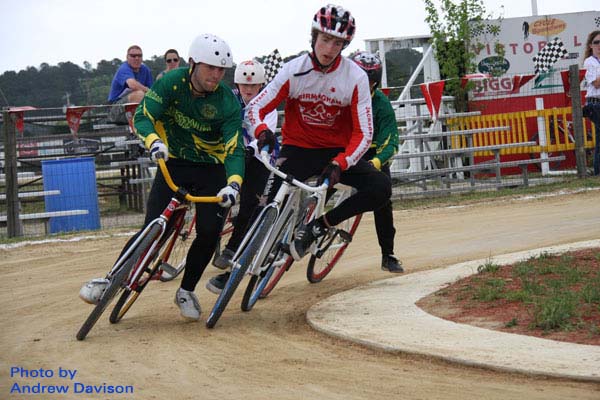 Paul Heard of Australia leaning into Cameron Crisp of England. One gear, no brakes, and no fear. Photo credit Andrew Davison.
Paul Heard of Australia leaning into Cameron Crisp of England. One gear, no brakes, and no fear. Photo credit Andrew Davison.
Cycle Speedway is a type of bicycle racing that is not well known in
the USA. It is an international sport, but Speedway’s creation was in
the United Kingdom. It consists of relatively short anaerobic races at
outdoor facilities built for the purpose. The cinder track is absolutely
flat and short, between 70–90 meters, and events are usually four laps
long.
The total race, depending upon the exact track, is approximately 280
to 360-meters. Your entire race may take about 40 seconds and consists
of 8 corners and 8 short straightaways.
BMX racing is closest to Cycle Speedway in time and distance. BMX
tracks are typically 300–400 meters, but make extensive use of berms and
jumps you don’t see in Speedway.
The refined and genteel track racing of a velodrome use one speed bikes with a banked track but it is nothing like Cycle Speedway.
Possibly it is the MTB racing called 4-Cross, with running times relatively close to Speedway, and multiple rider starts with contact permitted. Speedway possibly is then 4X of the horizontal plane.
In Cycle Speedway racing, contact is legal and often necessary. This does not mean you are allowed to T-bone another rider, but there will be contact, especially at turns. Riders must wear full pants and long sleeved jerseys. Gloves and kneepads are also a good idea, in addition to the mandatory helmet. Rules define any sport and its tactics, and these are laid by the British Federation Cycle Speedway. Section 6 details the equipment, and it begins with the machine:
SECTION 6.1: A racing machine shall not be fitted with brakes, brake attachments, mudguards, rat-trap or all metal pedals, toe clips or straps, lamp brackets, wing-nuts, any form of gears or any other fittings considered dangerous by the referee.
That’s right, the rules state there are to be no brakes of any sort on the bike, and don’t even think about those aero bar attachments. However, you must also use a freewheel, not a fixed gear. With average speed perhaps 28 kph (approx. 18 mph), how do you control speed? Your feet!
The role of the mechanic is to fit the workings of the machine to the particular needs of the rider. I find this aspect very fulfilling. I admit I was very jealous of fellow mechanic Dean McCall of Mountain Sports. He was called upon to provided technical support to any athlete needing it at the 2011 Cycle Speedway World Championships. This was the first time ever these World Championships were held in the USA, in Edenton, North Carolina. Riders came from England, Scotland, Wales, Australia, Poland and the US.
I have never worked this kind of racing, or even seen a race in person. Mr. McCall was kind enough to provide us with some insight into this sport. Dean’s report here is in italics, and my comments are [CJ—in brackets like this].
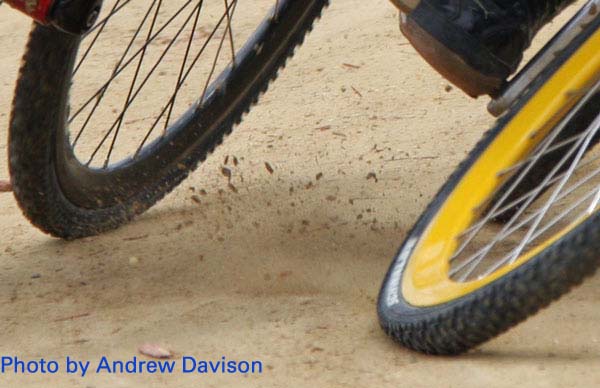 Now we're tearing it up where the rubber meets the track! Photo credit Andrew Davison.
Now we're tearing it up where the rubber meets the track! Photo credit Andrew Davison.
These guys know how to ride a bike. The Australian team manager, Brian Chadwick, had one of the best descriptions: “Rugby on Wheels.” Four riders at a time race four laps. Standing start. It is very close racing and contact is allowed, but only within the rules. It was amazing to watch these guys—and gals—go at it. The bikes are similar to track bikes, no brakes, a light but robust frame—cro-moly, aluminum, and even one titanium. Tires were mostly Schwalbe 26 x 1-3/8″ (E.T.R.T.O. 37-590). The Polish team were using Maxxis 26 x 1,75. The 2011 World Champion is from Poland and he really had to earn it. [CJ: the 26 x 1-3/8″ is the “English 3 speed” standard tires on the older Raleighs, a piece of legacy for the sport. The decimal 26 x 1.75 is the E.T.R.T.O size of 559, the common MTB tyre.]
My learning curve was purely vertical for this event and it was great. It is a puzzle as to why this type bike racing is not known here. It’s very much like the early days of NASCAR—just on two wheels. The Aussies talked me into entering the veteran class. The defending world champion, Australian Daniel Pudney, let me use his bike. I ended up tied for 11th place. Those young guys beat me like I was the front porch rug, but I was the highest finishing American rider. It was a hoot.
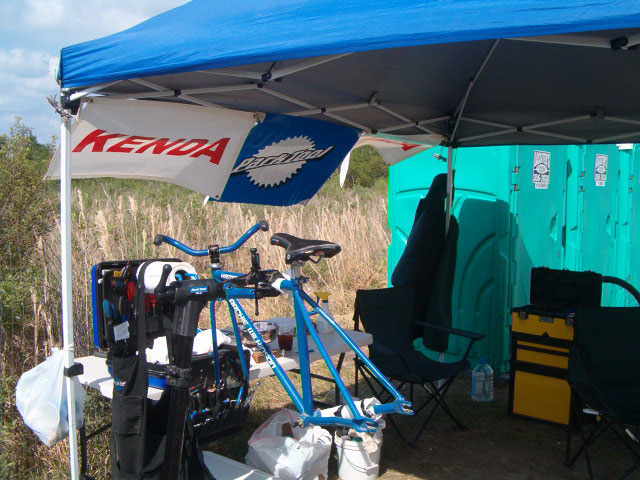
The PRS-25 stands ready to serve, and so do the biffies. Not a bad location, as everyone will find you. Photo credit Dean McCall.
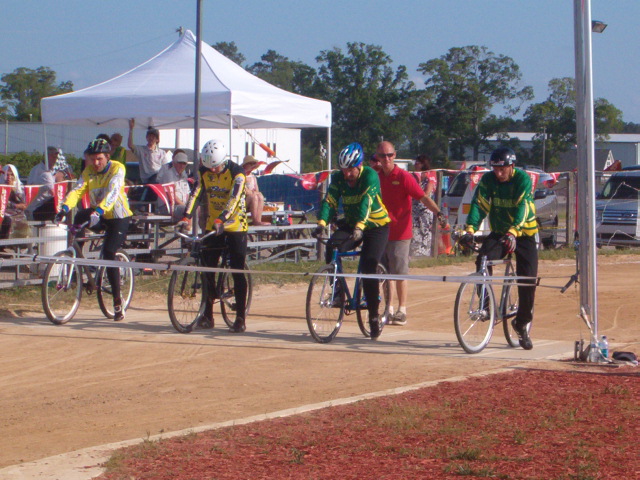
Riders ready at the gate. The gate lifts vertically at the starter's order. Photo credit Dean McCall.
I took the FFS-2 as an afterthought, but we used it on 7 forks and several frames. We were pitted right beside the porta-johns. There is nothing in the Race Mechanics Handbook about how to deal with that! But we did get to see just about everyone who came to the track—and they saw the banner.
A good start is absolutely vital. After the gate, it was almost always a crush in the first turn. There are team races where team tactics & team riding are acceptable. In the individual heats however, if the referee sees team riding—blocking—the offender is “Excluded” from that heat and receives no points, and if it is blatant, then the referee can exclude all the “team” riders and restart the heat without the excluded riders—therefore no points for them. After the qualifications, the final 16 riders will race 5 times each through a series of 20 heats with the total points determining the winner. 4 points for each 1st place finish, 3 for 2nd, 2 for 3rd and 1 point for 4th. Any ties are settled by a single runoff heat. This occurred in several of the final championship races.
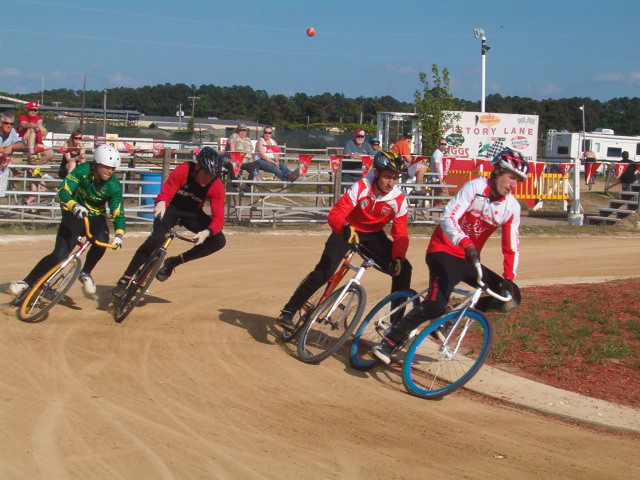
Poland leading into the corner. Photo credit Dean McCall.
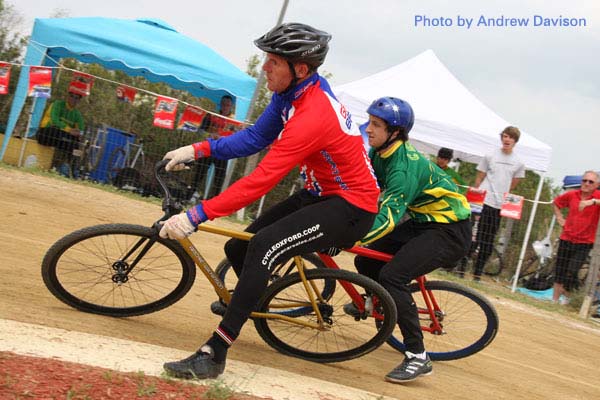
Steve Harris of England and Cody Chadwick of Australia on the outside. Feet are allowed on the cement infield skirt, but not your wheels. Photo credit Andrew Davison.
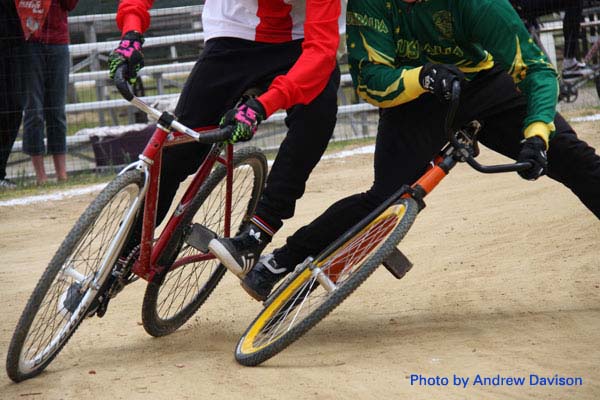 There's good action here. Australian Joel Chadwick is trying to get inside Aaron Morgan, England. I would love to see the image just a half a second after this one.The inside rider is leaning way over, and will probably keep it upright, but all that foot dragging will slow him as well. The rider on the outside can have more speed but also has a longer line. Cycle Speedway... a lesson in Newtonian physics with every lap. Photo credit Andrew Davison.
There's good action here. Australian Joel Chadwick is trying to get inside Aaron Morgan, England. I would love to see the image just a half a second after this one.The inside rider is leaning way over, and will probably keep it upright, but all that foot dragging will slow him as well. The rider on the outside can have more speed but also has a longer line. Cycle Speedway... a lesson in Newtonian physics with every lap. Photo credit Andrew Davison.
The primary tactic when the gate goes is to get to the turn first, then accelerate to the next turn as fast as possible, trying to stay as close inside the turn as possible, then repeat that eight times over the four laps. Passing on the inside was possible and frequent. If the rider in front was not in close enough, the following rider could put a front wheel in moving the front rider wide coming out of the turn then it’s a drag race down the next straight-often shoulder to shoulder and sometimes through the next turn & following straight still shoulder to shoulder.
The bikes, the riders and the contact, all were fast and furious. If the lead rider was not fast enough, i.e. staying too tight in the turns, the following riders could and would pass on the outside. This was intense racing and an absolute thrill to watch.
Every team, except the Polish, was using the Schwalbe Speedway Pro 26 x 1-3/8″ (37-590). Apparently these tires are special editions produced for Archie Wilkinson, the guru of cycle speedway racing. The tread pattern looks like small figure 8s with two rows offset in center and the side rows. The pattern looks very much like the old Kenda MX K-50 tires. Tioga had a similar design as well. Pressures ranged from 35–45 psi—usually equal Front & Rear, although two riders asked for 75 psi. Pressures were changed as track conditions changed. At night, when then track surface—originally loose sand/clay—began to harden, pressures were increased to add traction. As a novice to this type racing, it appears to me that the relatively narrow tire allows for traction on the loose track surface while affording controllable drifts in the turns and good acceleration down the straights. The defending world champion, Australian Daniel Pudney, had this setup. With all of the beating & banging, tubulars would seem to be impractical. The Polish team used 26″ MTB wheels with 1.75″ & 1.95″ Maxxis tires.
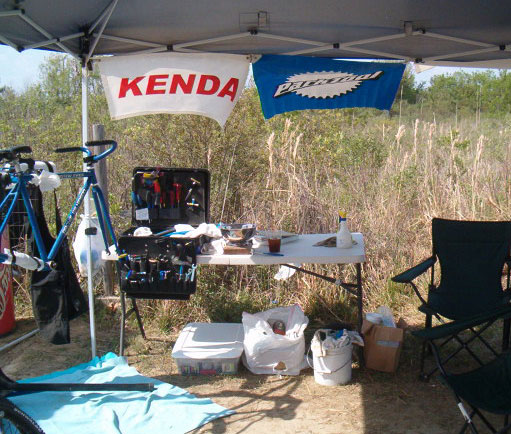
A well set up pit. Notice Dean's choice of rug under the work area. It provides a nice accent, and keeps those small parts you will eventually drop out of the dirt.
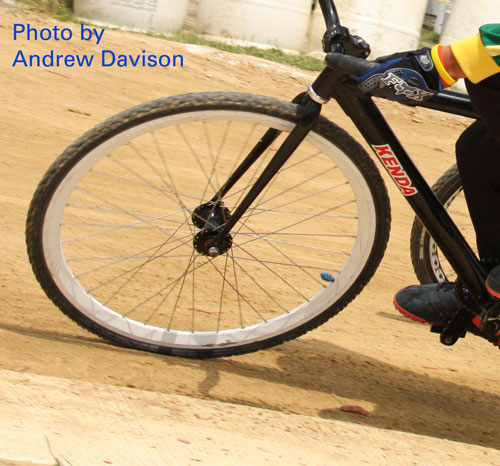
Forks have no offset or rake. The blades and axle nuts are in line with headtube. The rim is the typical deep cross section, with the addition of a nice valve cap. Photo credit Andrew Davidson.
Spoke patterns were all 3X—most 32 hole with a few 36. One rider did have a radial front pattern. No carbon in sight—I would say because of the B&B. Almost all the rims & hubs were no-name, no labels, decals or stickers to be seen. The Rims were a deep design, approx. 80 mm, 20 mm width. They looked similar to the aero design road rims. The deep rims were used for the strength—less flex in the turns.
Cranks were 85% three piece-square taper & 15% two piece external bearing BB. Several brands which I had not seen before, but the Park Tool fit them all.
The predominant frame by far was the Archie Wilkinson. Typical weights were 17–20 pounds. Most of the frames were Chrome-Moly, a few aluminum and one Lynskey, which was ridden by the Polish rider Lukasz Nowacki. Lukas is the 2011 Senior World Champion. We worked on almost all of these bikes at one time or another during the event, and as far as I can tell, there was no significant weight differential.
Most of the chains were 1/8\", a few 3/32\", 2 or 3 3/16\" and one that was at least 1/4\". Several of the chains were of the half-link design. Most wanted their chain at a "medium/tight" tension, but not so tight that the cranks would not spin freely. Most common gear by far was 34 x 18. Some of the juniors used a 33 x 18. One that I saw had 32 x 16.
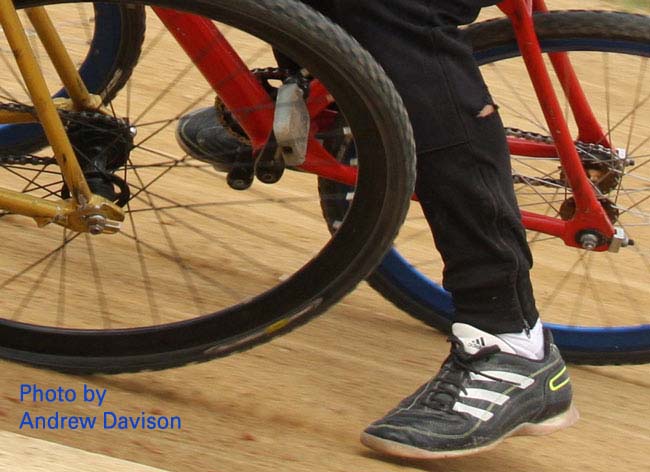 Let's have a closer look at the relevant equipment, beginning with some sturdy shoes for sliding on the corners. The bikes and the riders' tights show a bit of wear. These chains appear to be the wider 1/8" standard, not the narrow 3/32" used for derailleur bikes. The dropouts are made for single speeds. The longer slot is rear exit and allows for changes to chainring sizes. The bike to the outside has a chain tensioner device to help set chain tension. These devices are seen also in BMX and track racing. The pedals are the mandatory simple block plastic design. No clipless pedals, no toe clips, no studs allowed. Photo credit Andrew Davison.
Let's have a closer look at the relevant equipment, beginning with some sturdy shoes for sliding on the corners. The bikes and the riders' tights show a bit of wear. These chains appear to be the wider 1/8" standard, not the narrow 3/32" used for derailleur bikes. The dropouts are made for single speeds. The longer slot is rear exit and allows for changes to chainring sizes. The bike to the outside has a chain tensioner device to help set chain tension. These devices are seen also in BMX and track racing. The pedals are the mandatory simple block plastic design. No clipless pedals, no toe clips, no studs allowed. Photo credit Andrew Davison.
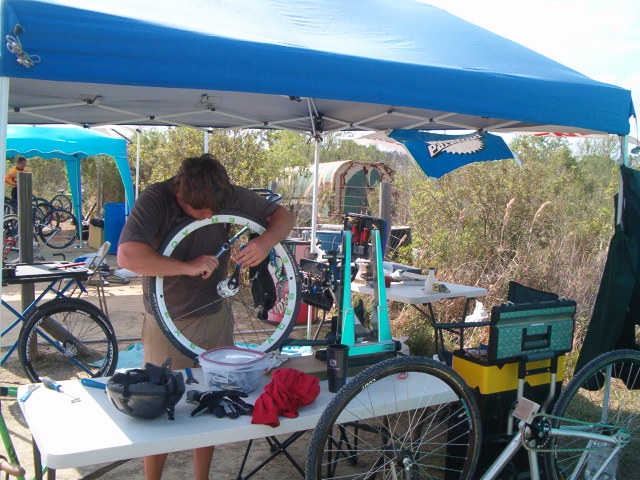 Colby McCall, son of Dean, wielding a SCW cone wrench in a hub adjustment. Photo credit Andrew Davidson.
Colby McCall, son of Dean, wielding a SCW cone wrench in a hub adjustment. Photo credit Andrew Davidson.
By far, the most common issue was wheel concerns, with loose cranks & loose BB a distant second/third. We replaced 16 tubes. Various reasons for the flats, from just really old tubes stuck inside the tire, damaged presta and Schrader stems, to NO rim strips at all. Lots of minor adjustments to bar position & stem position & tightening the odd bolt here & there. The forks on these bikes offer 0 trail—needed for the control in the turns—we did straighten several forks & seat/chain stays.
We had several interesting repairs—most from lack of maintenance—hub bearings, loose & sealed, headset repairs & BB repairs. With no brakes or shifters/deraileurs, the bikes are relatively simple, although an advanced level of simple
If an incident occurs during a heat, the referee usually only allows 2 minutes for everyone to return to the start—they start a new 4 lap heat from the beginning—so if a bike has serious damage, the rider will grab a teammate’s bike to finish. But there may be only 1 or 2 heats before the rider races again, so time is a major issue. If a rider misses his/her heat, then no points are awarded to that rider. - Dean McCall
Calvin Jones again:
Cycle Speedway in the USA began in Prescott Arizona, known as “CS AZ”. Using a flat grassy area starting in 2002, Begun by David Cooke Sr built the program up to full International CS stands, eventually hosting an International between Great Britain and the USA in 2004. In 2008 sponsorship funding faded and the program closed.
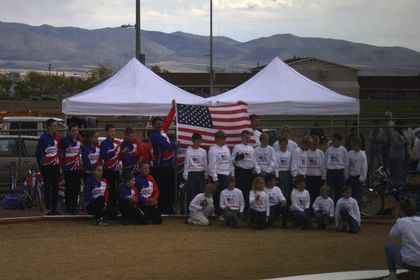 Great Britain versus the USA at an International, Prescott Arizona.
Great Britain versus the USA at an International, Prescott Arizona.
Speedway made another showing in the USA, this time in North Carolina and this race. That program has also since dissolved. What the future holds for Cycle Speedway in the USA remains to be seen.
Cycle Speedway has yet to catch fire in America. When it does, it
will raise the level of all cycling. It is a very pure form of racing...
step on the accelerator and turn left. For this racing to work, it
takes leagues. I could easily envision competitive high school programs
based
on Cycle Speedway. No traffic, no cars, just straight up fun. What a feeder to other cycling disciplines!
To give you a better understanding of Speedway, enjoy the video below, produced by Cycle Oxford in the UK.
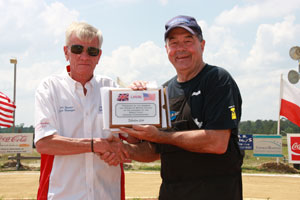 Dean McCall (right) receives his recognition from the English Team Captain Pete Barnes. Photo credit Andrew Davidson.
Dean McCall (right) receives his recognition from the English Team Captain Pete Barnes. Photo credit Andrew Davidson.
A special thanks goes out to Dean McCall. I always enjoy learning about new racing and how people use their bikes. Wherever people are riding bikes, that’s where mechanics should be. Dean answered the call for service, and I for one feel all the richer for his work.